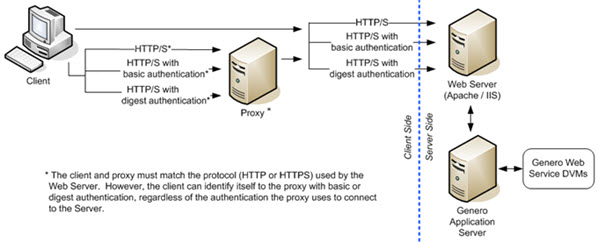Accessing secured services
Security and authentication are important. Genero Web Services provides various communications options for a client to connect to a Web service.

- HTTP
- Client connects to a Web Server (or a Web Service) using HTTP as the communication protocol. (No security , No authentication).
- HTTP with Basic Authentication
- Client connects to a Web Server using HTTP as the communication protocol, but a valid login and password are required from the Web server to grant access to the Web Service. (No security , Weak Authentication). The login and password are sent in clear text on the communication layer.
- HTTP with Digest Authentication
- Client connects to the Web Server using HTTP as the communication protocol, but a valid login and password are required from the Web server to grant access to the Web Service. (No security , Authentication). The login and password are encoded using a digest algorithm, requiring additional information from the Web server. This means that the first connection will always fail, but it is necessary in order to return Web server additional information back to the client.
- HTTPS
- Client connects to a Web server using HTTPS as the communication protocol. (Security , No authentication). The communication channel is encrypted by SSL/TLS.
- HTTPS with Basic Authentication
- Client connects to a Web server using HTTPS as the communication protocol, but a valid login and password are required from the Web server to grant access to the Web Service. (Security , Weak Authentication). The login and password are sent in clear text on the communication layer, but the communication channel is encrypted by SSL/TLS.
- HTTPS with Digest Authentication
- Client connects to the Web Server using HTTPS as the communication protocol, but a valid login and password are required from the Web server to grant access to the Web Service. (Security , Authentication). The login and password are encoded using a digest algorithm, requiring additional information from the Web server. This means that the first connection will always fail, but it is necessary in order to return Web server additional information back to the client. The communication channel is encrypted by SSL/TLS.
To improve communication speed with the cache mechanism, or to restrict internet access to specific clients, Genero Web Services allows a client to connect via proxies. The proxy is in charge of dispatching the client request to the server, and uses the same protocol as that used by the server. So, when a client connects via a proxy to access a HTTP server, the configuration of the HTTP proxy is used, and when the client communicates in HTTPS, the HTTPS proxy configuration is used.
- HTTP proxy
- Client connects via a proxy using HTTP as the communication protocol.
- HTTP proxy with Basic Authentication
- Client connects via a proxy using HTTP as the communication protocol, but a valid login and password are required from the proxy to dispatch the request to the Web Service. The login and password are sent in clear text on the communication layer between client and proxy.
- HTTP proxy with Digest Authentication
- Client connects via a proxy using HTTP as the communication protocol, but a valid login and password are required from the proxy to dispatch the request to the Web Service. The login and password are encoded using a digest algorithm, requiring additional information from the proxy. This means that the first connection will always fail, but it is necessary in order to return proxy additional information back to the client.
- HTTPS proxy
- Client connects via a proxy using HTTPS as the communication protocol. The communication channel is encrypted by SSL/TLS.
- HTTPS proxy with Basic Authentication
- Client connects via a proxy using HTTPS as the communication protocol, but a valid login and password are required from the proxy to dispatch the request to the Web Service. The login and password are sent in clear text on the communication layer between client and proxy, but the communication channel is encrypted by SSL/TLS.
- HTTPS proxy with Digest Authentication
- Client connects via a proxy using HTTPS as the communication protocol, but a valid login and password are required from the proxy to dispatch the request to the Web Service. The login and password are encoded using a digest algorithm, requiring additional information from the proxy. This means that the first connection will always fail, but it is necessary in order to return proxy additional information back to the client. The communication channel between client and proxy is encrypted by SSL/TLS.